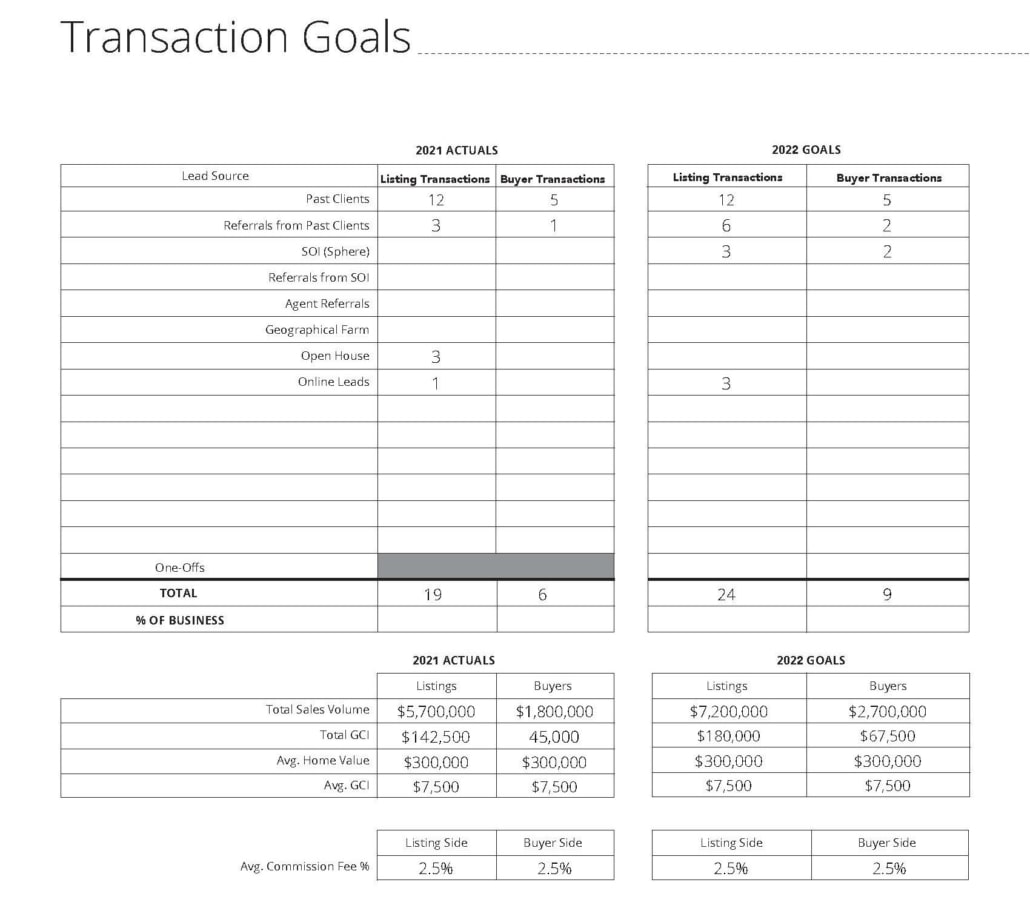2022 Business Planning for Real Estate Agents
How are you planning for 2022 to ensure it’s a successful and meaningful year?
Did you know that, on average, 30% of a real estate agent’s business typically comes from repeat clients or referrals? But if you just waited for referrals to come in, you likely wouldn’t be able to feed your family! So how do you plan for the year ahead, ensuring that your repeat customer and referral business continues to increase?
Very few of us enjoy planning, but it’s truly the key to a successful real estate agency. That’s why we’re here to make it easy for you. Often, planning templates require you to go in-depth, and that can be daunting. But if you simplify your business planning process, you’re more likely to sit down and do it.
Below, we’ve taken the highest-impact forms from a full real estate business planner courtesy of WFG National Insurance Title Company. While we’d encourage you to dive deep and use the full planner (which you can download at the end of this blog), if you just focus on goal-setting and simple marketing strategies, you’ll be a lot farther ahead than most agents. Armed with a plan for 2022, you’ll be confident as you jump back into the workplace after the holiday season.
So let’s get started.
![]()
Transaction Goal Setting
Before you start mapping out your transaction goals for the year, take some time to write down your vision for your business. Where do you see yourself in three to five years from now? What is your long-term goal? From there, clarify your mission statement. This should be a simple sentence that clearly communicates the purpose of your business. Every business owner should be clear on their vision and mission. Kickoff your planning by making sure those two critical things are dialed in.
Then you can dive into setting goals for your business. Below, we’ve shared a great template for you. Start by filling in last year’s number of transactions. Look at both the listing side and the buyer side. And just count transactions, not leads. How many transactions did you get from past clients? How many from your personal sphere of influence? How many referrals did you get from agents, past clients, or your sphere? What were your total sales volume and gross commissionable income? Then look at your averages both in terms of GCI and commission fee.
How much do you want to grow in the new year? Use the second set of columns to build your 2022 goals. Simple and straightforward. Again, if you do this and only this, you’re ahead of the game! But there’s more. Once you know where you’re going, you have to determine your path to get there. Scroll down for the next high-impact planning activity.
Transaction Goal Setting Example:

![]()
Activity Goal Setting
Are you tracking the conversations you have? Do you know how many conversations you need to have over the course of a year in order to reach your goals? You may not have this data at your fingertips, but we’d encourage you to start tracking it. How many conversations do you have to have before you close a transaction? And how long do each of those conversations take? Once you know some of these averages, you can reverse engineer your year.
For example, if you want to close 25 listing transactions in a year, that means you need to have at least 35 leads (as most of us don’t have a 100% close rate). If each lead takes six conversations to close, that means you’ll need to have approximately 210 conversations over the course of the year. If each of those conversations lasts an hour, you’re looking at 210 hours per year. This is an extremely simple example, but it’s a great place to start. You can now work backward and determine how much time you need to spend each week talking to leads in order to reach your goal. That, of course, begs the question: how do we generate those leads? Let’s turn our attention to marketing.
![]()
The Real Estate Agent Marketing Plan
Does your sphere of influence know what you do? Is your name associated with the real estate industry? That’s brand awareness, and it’s crucial that you build it first. The second step is turning that awareness into actual leads for your business. No real estate business can generate leads without a basic marketing plan. So take some time to formulate how you’re going to communicate with your audience. This template should help.
What makes you stand out in the marketplace? In marketing-speak, this is your Unique Selling Proposition (USP). The questions below will help you formulate your one-sentence point of differentiation. This USP will guide the messaging you use in your marketing.
We love this template as it can be used multiple times for different audiences. In the example below, the lead source is a geographic farm of a particular neighborhood. You’ll take that audience and determine how you’ll reach them through the channels listed below. You’ll advertise to them using Facebook videos and mailers; you’ll network with them through community events, and so on.
Use one form for each lead source or audience.

![]()
Conclusion
This is just the tip of the iceberg when it comes to true business planning. But these simple steps will set you up for success in the coming year. Because, after all, “a goal without a plan is just a wish.” Antoine de Saint-Exupery.
![]()
Click the button below to download full business planning template!





